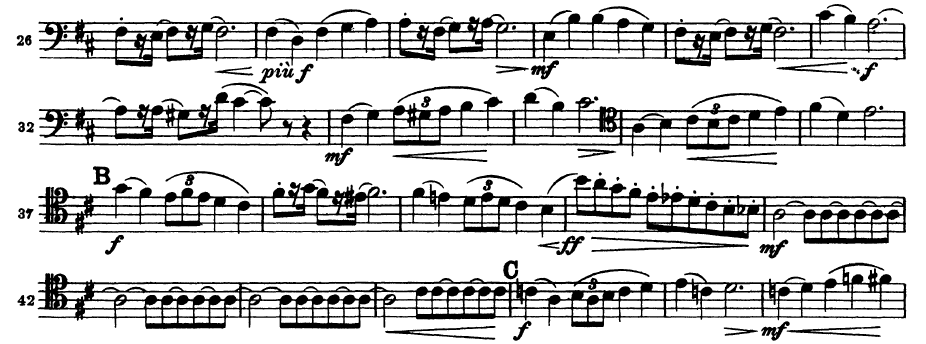Peter Ilyich Tchaikovsky
Symphony No.6 in B minor (Pathetique), Op.74, Movement 2 Allegro con grazia
- 1st and 2nd bassoon m. 26-42 (17 total measures)
- Range – (D-High B)
- Bass and tenor clef
Performance issues: Phrasing. Rhythm, Accidentals, Articulation, High register

About the music: This movement is included in the collection because of its meet unique style. Within the symphony, it provides contrast for the dramatic quality of the first movement. There is a waltz-like quality to the movement, a sense derived from the light styling rather than a strict examination of meter.
This theme is first introduced by the celli and then moves to the upper woodwinds, so in rehearsal, there is ample time to acclimate to the asymmetrical meter. All of the woodwinds share this melodic statement, a good example of Tchaikovsky’s blended writing. As established by other of his excerpts in this collection, he was a Romantic composer who valued the individual instrument colors more than some of his contemporaries. At the same time, he wrote well for combined colors when the increased voicing would serve some other musical purpose.
About performing the excerpt: The passage breaks down into manageable two-measure units and it is suggested that the student master each unit before combining them into a whole. For the development of ease in 5/4 meter, both scales and articulation drills can easily be translated into this meter, so that the student may become comfortable with the asymmetrical feel. (Measures in 5/4 are usually grouped into 3+2 or 2+3 to create a secondary stress somewhere within the measure. This movement is of the 2+3 variety.) Duet material is provided to include the harmonization of the basic melody, and playing the two parts will be reinforcing rhythmically since the parts are identical. When secure, the passage should be made “free” in effect, and the excerpt should take on a graceful, lilting feel.
The grouping of this and the preceding except for study purposes is recommended for the more skilled student. Initially, each of the two passages will be sufficient alone for concentration on their varied performance problems.